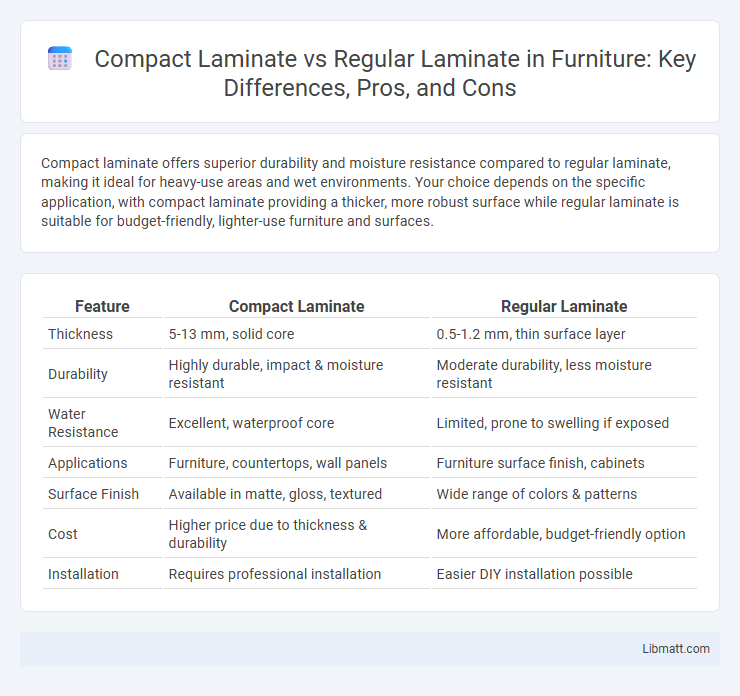Compact laminate offers superior durability and moisture resistance compared to regular laminate, making it ideal for heavy-use areas and wet environments. Your choice depends on the specific application, with compact laminate providing a thicker, more robust surface while regular laminate is suitable for budget-friendly, lighter-use furniture and surfaces.
Table of Comparison
| Feature | Compact Laminate | Regular Laminate |
|---|---|---|
| Thickness | 5-13 mm, solid core | 0.5-1.2 mm, thin surface layer |
| Durability | Highly durable, impact & moisture resistant | Moderate durability, less moisture resistant |
| Water Resistance | Excellent, waterproof core | Limited, prone to swelling if exposed |
| Applications | Furniture, countertops, wall panels | Furniture surface finish, cabinets |
| Surface Finish | Available in matte, gloss, textured | Wide range of colors & patterns |
| Cost | Higher price due to thickness & durability | More affordable, budget-friendly option |
| Installation | Requires professional installation | Easier DIY installation possible |
Introduction to Compact Laminate and Regular Laminate
Compact laminate is a dense, highly durable material composed of multiple layers of kraft paper impregnated with phenolic resin, making it suitable for heavy-duty applications such as countertops and wall cladding. Regular laminate, often known as decorative laminate or high-pressure laminate (HPL), consists of a decorative surface layer fused to a particleboard or MDF core, primarily used for furniture and cabinetry. Your choice between compact and regular laminate should consider factors like thickness, moisture resistance, and durability requirements.
Material Composition and Structure
Compact laminate consists of multiple layers of kraft paper saturated with phenolic resin, fused under high heat and pressure into a dense, solid sheet without a core, making it thicker and more durable than regular laminate. Regular laminate, also known as high-pressure laminate (HPL), has a layered structure with a decorative paper layer over kraft paper layers, requiring a substrate like particleboard or MDF for support. Your choice depends on how the material composition influences strength, moisture resistance, and application needs.
Durability and Strength Comparison
Compact laminate demonstrates superior durability and strength compared to regular laminate due to its thicker and denser composition, often exceeding 3mm in thickness, which enhances resistance to impact, moisture, and wear. Regular laminate, generally thinner and composed of a core layer with a decorative surface, is more susceptible to chipping, swelling, and delamination under heavy use or exposure to water. The robust construction of compact laminate makes it ideal for high-traffic commercial applications and environments requiring enhanced structural integrity.
Water and Moisture Resistance
Compact laminate offers superior water and moisture resistance compared to regular laminate due to its denser structure and absence of a core material prone to swelling. Your surfaces made with compact laminate resist warping, delamination, and bacterial growth, making them ideal for wet environments like kitchens and bathrooms. Regular laminate, with its particleboard or MDF core, tends to absorb water, leading to damage and reduced durability over time.
Aesthetic Options and Design Flexibility
Compact laminate offers a broader range of aesthetic options and superior design flexibility compared to regular laminate, thanks to its thickness and durability, which allow for seamless edges and complex shapes without additional edging. It supports diverse textures, colors, and patterns, making it ideal for modern, high-traffic environments where custom designs are essential. Regular laminate, while available in various styles, often requires edge banding and has limitations in creating intricate or seamless designs, reducing its overall versatility in sophisticated interior applications.
Applications: Where Each Laminate Excels
Compact laminate excels in high-traffic areas requiring durability and moisture resistance, such as kitchen countertops, laboratory surfaces, and bathroom vanities, due to its solid construction and thickness. Regular laminate is ideal for decorative surfaces on furniture, cabinets, and wall panels where cost-efficiency and design versatility are priorities, but less exposure to heavy wear or moisture is expected. Your choice depends on the specific application requirements, balancing durability needs with aesthetic preferences and budget.
Installation Process and Techniques
Compact laminate features a simplified installation process due to its one-piece, self-supporting design that eliminates the need for additional substrate or core material. Regular laminate requires a multi-step installation involving adhesive application over a substrate, precise cutting, and additional edge finishing techniques to prevent moisture infiltration. Your choice impacts labor time and skill level, with compact laminate offering faster, more straightforward installation suited for high-traffic or wet environments.
Maintenance and Cleaning Requirements
Compact laminate offers superior durability with a non-porous surface that resists stains, moisture, and scratches, requiring only simple cleaning with mild soap and water. Regular laminate, consisting of a fiberboard core with a thin decorative layer, is more susceptible to water damage and delamination, necessitating careful wiping and immediate spill cleanup to prolong its lifespan. Both materials benefit from avoiding harsh chemicals and abrasive scrubbers to maintain their appearance and integrity.
Cost Analysis: Compact vs. Regular Laminate
Compact laminate generally costs more upfront than regular laminate due to its increased thickness, density, and durability, making it a premium choice for heavy-use surfaces. Regular laminate offers a more budget-friendly option with a thinner composition, suitable for standard residential applications where high impact resistance is less critical. Considering lifespan and maintenance, compact laminate can prove more cost-effective over time by reducing replacement and repair expenses.
Which Laminate Type Is Best for Your Project?
Compact laminate offers superior durability and moisture resistance compared to regular laminate, making it ideal for high-traffic or wet areas such as kitchens and bathrooms. Regular laminate is more cost-effective and suitable for standard applications like cabinetry and furniture where heavy wear is minimal. You should choose compact laminate if your project demands enhanced strength and longevity, while regular laminate suits budget-conscious projects with lighter usage.
compact laminate vs regular laminate Infographic

 libmatt.com
libmatt.com